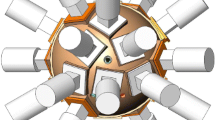Abstract
Fission products contain a wealth of information on the fission process, but typically one dimensional data is extracted, such as a mass or energy distribution. Highly correlated data is valuable for better understanding of the fission process, and is in demand for fission theory. Correlated fission data sets were taken on the University of New Mexico (UNM) Fission Spectrometer using dedicated detectors, analog electronics, and digital data acquisition. Timing module detectors and an axial ionization chamber made for the spectrometer were employed to provide the raw signal pulses. Analog signal processing treated the detector signals and performed fast time comparisons to extract product time of flight and ionization chamber drift time. These signals, combined with the anode and gamma ray detector signals, were put through the digitizer, and pulse heights and time stamps were recorded. This allowed us to set coincidence windows for combining the data into event packets corresponding to individual fission products. From the coincidence events we are able to extract velocity, kinetic energy, mass, information on atomic number, and coincident gamma rays, particle-by-particle from ejected fission products.











source at UNM.



Similar content being viewed by others
References
Baldez, B. P., Fellows, S., Blakeley, R. E., Tanguay, M., Wetzel, M. L., Hecht, A. A., Mayorov, D., Tovesson, F., Winkelbauer, J. (2019). Measurements of 252Cf fission product energy loss through thin silicon nitride and carbon foils, and comparison with SRIM-2013 and MCNP6.2 simulations, Nuclear Instruments and Methods B 456, 142–147. https://doi.org/10.1016/j.nimb.2019.06.027
BNL. (2015). Nuclear Data Needs and Capabilities for Applications USNDP Collaboration May 27–29, 2015, Brookhaven National Laboratory, BNL- 108491–2015-IR.
CAEN. (2019). User Manual UM3182, MC2Analyzer User Manual, Rev. 10. https://www.caen.it/products/mc2analyzer/
CAEN. (2021). User Manual UM5960, CoMPASS Multiparametric DAQ Software for Physics Applications, Rev. 14 - February 17th. https://www.caen.it/compass/
Duke, D. (2015). Fission Fragment Mass Distributions And Total Kinetic Energy Release Of 235-Uranium And 238-Uranium In Neutron-Induced Fission At Intermediate And Fast Neutron Energies, LA-UR-15–28829, Ph.D. Dissertation, Applied Physics, Colorado School of Mines.
Evans, R. B. (1955). The Atomic Nucleus. McGray-Hill Inc.
Garosi. (2020). Private communication, Dr. Poala Garosi, applications scientist CAEN S.p.A.
Hamamatsu. (2021). Specification Sheet TMCP1038E04, MCP Assembly F9890–21/32, May. https://www.hamamatsu.com/resources/pdf/etd/F9890-31_-32_TMCP1038E.pdf
Hecht, A. A. (2004). Nuclear Chiral Symmetry in the Mass A ~ 130 Region, Ph.D. Dissertation, Department of Physics, Yale University.
Knoll, G. F. (2010). Radiation Detection and Measurement (4th ed.). John Wiley & Sons Inc.
Meierbachtol, K., Tovesson, F., Shields, D., Arnold, C., Blakeley, R., Bredeweg, T., Devlin, M., Hecht, A. A., Heffern, L. E., Jorgenson, J., Laptev, A., Mader, D., O׳Donnell, J. M., Sierk, A., White, M. (2015). The SPIDER fission product spectrometer for fission product yield measurements, Nuclear Instruments and Methods in Physics Research Section A 788, 59–66. https://doi.org/10.1016/j.nima.2015.02.032
Nuclear Data Center, Japan Atomic Energy Agency. (2021). using JENDL FP Fission Yields Data File. Accessed 5 May 2021. https://wwwndc.jaea.go.jp/cgi-bin/FPYfig
Oed, A., Geltenbort, P., Gönnenwein, F., Manning, T., & Souque, D. (1983). High Resolution Axial Ionization Chamber for Fission Products. Nuclear Instruments and Methods, 205, 455–459.
Pomp, S., Lantz, M., Solders, A., Mattera, A., Rakopoulos, V., Al-Adili, A., Prokofiev, A. (2015). Accurate Fission Data for Nuclear Safety Final Report, Uppsala University.
Robinson. (2020). Private communication, Columbine Robinson, Hamamatsu Photonics.
Schmitt, H. W., Kiker, W. E., Williams, C. W. (1965). Precision Measurements of Correlated Energies and Velocities of 252Cf Fission Products, Physical Review, Vol 137, 48.
Sanami, T., Hagiwara, M., Oishi, T., Baba, M., Takada, M. (2008). A Bragg Curve Counter with an Active Cathode to Improve the Energy Threshold in Product Measurements, Nuclear Instruments and Methods A 589, 193–201. https://doi.org/10.1016/j.nima.2008.02.015
Schroeder, L., Lusk, E. (Eds.). (2006). Report of the Nuclear Physics and Related Computational Science R&D for Advanced Fuel Cycles Workshop, Bethesda, Md., August 10–12.
SRIM. (2013). SRIM-2013 manual and code available from http://www.SRIM.org/
The Nuclear Energy Agency. (2021). High Priority Request List (HPRL) for Nuclear Data. Accessed 5 May. https://www.oecd-nea.org/dbdata/hprl/index.html
Tovesson, F., Duke, D. L., Manning, B., Meharchand, R., Meierbachtol, K., Mosby, S., Shield, D. (2015). Studies of fission fragment properties at LANSCE, Proceedings of the 14th International Conference on Nuclear Reaction Mechanisms, Varenna (Italy), Villa Monastero, June 15–19.
Turner, J. E. (1995) Atoms, Radiation, and Radiation Protection, second ed., John Wiley & Sons, Inc.
Werner, J. (Ed.). (2017) MCNP User’s Manual – Code Version 6.2, LANL, Los Alamos, NM, USA, Rep. LA-UR-17-29981.
Ziegler, J. F., Ziegler, M. D., & J.P. (2010). Biersack, SRIM – The stopping and range of ions in matter. Nuclear Instrument Methods Phyiscs. Research Section B, 268(11–12), 1818–1823. https://doi.org/10.1016/j.nimb.2010.02.091
Acknowledgements
This work is partially supported by the NNSA Stewardship Science Academic Alliance, grant number DE-NA0003901. This leverages prior development work that was partially supported by DOE-NEUP, grant number DE-NE0000732.
Author information
Authors and Affiliations
Corresponding author
Additional information
Publisher's Note
Springer Nature remains neutral with regard to jurisdictional claims in published maps and institutional affiliations.
Rights and permissions
About this article
Cite this article
Baldez, P., Wetzel, M.L., Blakeley, R.E. et al. Signal Processing and Data Acquisition for the UNM Fission Spectrometer to Measure Binary Fission Product Mass, Energy, Velocity, Atomic Number, and Gamma Rays, Correlated Particle-By-Particle. J Sign Process Syst 94, 361–376 (2022). https://doi.org/10.1007/s11265-021-01703-w
Received:
Revised:
Accepted:
Published:
Issue Date:
DOI: https://doi.org/10.1007/s11265-021-01703-w




